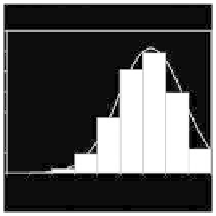Biology Reference
In-Depth Information
Science never solves a problem without creating ten more.
George Bernard Shaw (1856-1950)
In this chapter, we continue examining how populations
evolve, focusing on genetic changes. Two apparently
contradictory characteristics are observable: a tendency
for populations to preserve variability by maintaining
the genetic status quo, versus the presence of continuing
genetic adaptation and change. These characteristics
represent the fundamental ideas of Mendelian genetics
and Darwinian evolution that coexist in synthesis in
contemporary biology. We shall consider mathematical
models describing the maintenance of genetic variability
in a population and analyze the change in the genetic
constitution of a population subjected to natural selection.
Chapter 3
MATHEMATICS IN
GENETICS
I. INTRODUCTION
A. Early Experiments
Introduction
The Earth is home to a tremendous variety of living
organisms, but what is the origin of this diversity? By
observing the similarities and differences among finches
in the Galapagos Archipelago, Charles Darwin
(1809-1882) came to question the prevailing idea that
species are immutable, and, after years of work, came to
the conclusion that species evolved over time. In 1859, he
published his revolutionary topic On the Origin of Species
by Means of Natural Selection. Darwin, however, had no
understanding of the molecular mechanisms that created
these variations or of the cellular mechanisms of heredity
which passed these variations onto the following
generations. Unknown to Darwin, while he was writing
his topic, experiments were underway in a monastery
garden that were to shed light on the rules of heredity.
Chromosomes and the Physical Basis
of Heredity
Hardy-Weinberg Law of Genetic
Equilibrium
The Effect of a Maladaptive or Lethal
Gene
More Complex Hereditary Patterns
Quantitative Traits
Genes, Environments, and Variation
in a Population
Gregor Mendel (1822-1884), an Augustinian monk and
schoolteacher, sought to understand the rules governing
the inheritance of different characteristics by designing
experiments using the garden pea, Pisum sativum. His
careful selection of seven traits with alternate forms, his
monitoring of the generations produced, and his counting
of the different types of offspring allowed him to deduce
the fundamental laws of genetics. Mendel took true-
breeding varieties of peas and crossed those with well-
defined alternative forms. He made multiple fertilizations
99












